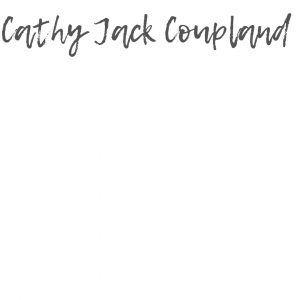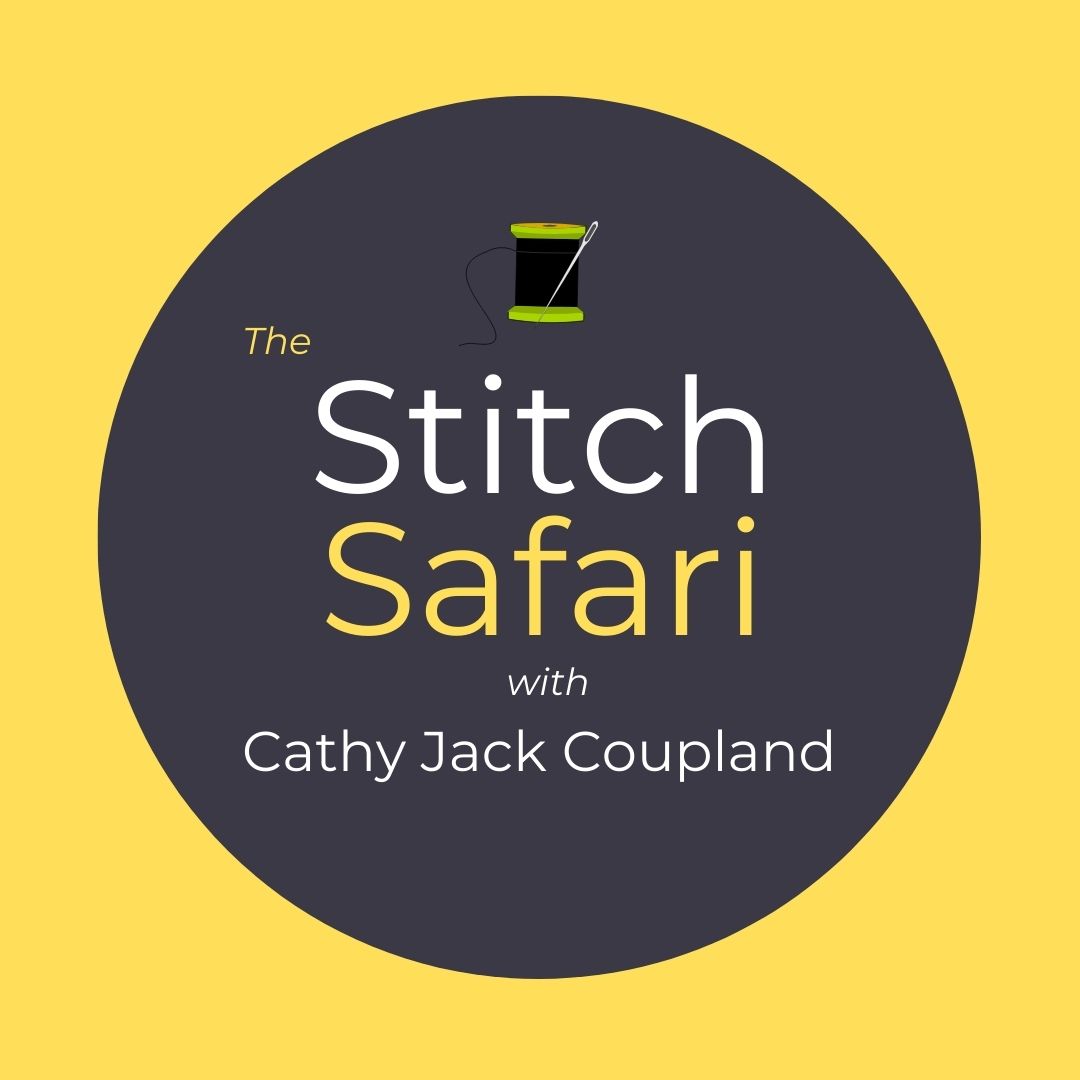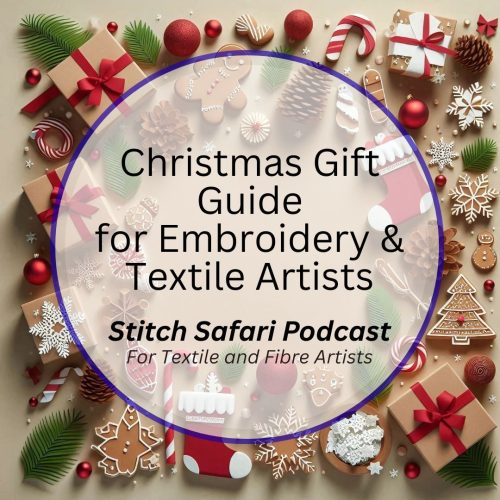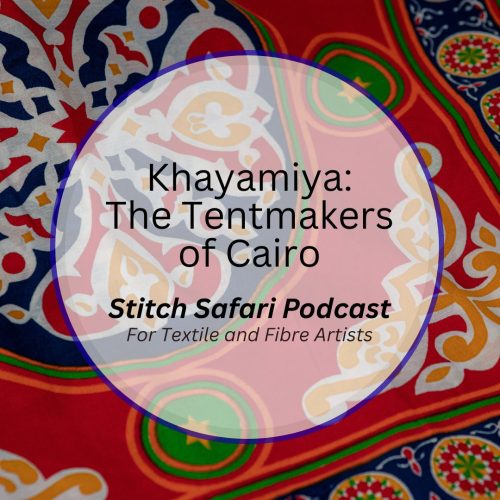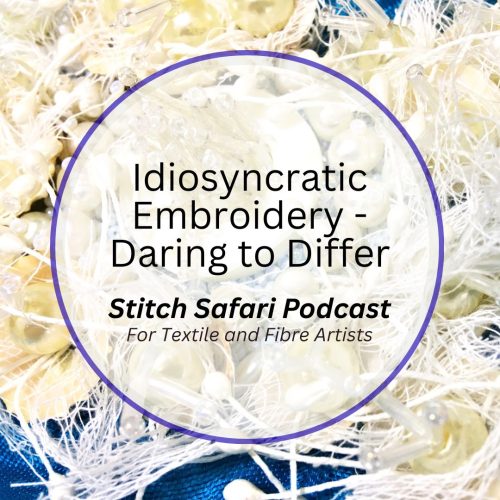This episode pays tribute to an embroidery artist who, from a very young age, was devoted to capturing and recording the beauty and complexity of nature, learning to note intricate details that would later lay a foundation for her work in textiles.
This Dutch-born artist migrated to Australia with her parents in 1951, unable to speak English yet becoming immersed in Australia’s unique flora and fauna, profound influencers for her artistic vision, promoted by a love of the freedom and open spaces Australia offered.
With a scientist’s eye, this artist immerses herself completely into her art by studying the life cycles of insects and animals, allowing her to portray her impression of their reality.
Stitch Safari listeners, I welcome you to a world of unsurpassed natural beauty, technical skill and pure magic, achieved by one of the most iconic and beloved Australian embroiderers, Annemieke Mein, OAM.
‘All great art is the combination of rare skill plus imagination’, Annemieke wrote of this long-remembered comment from her father. ‘Good craftsmanship is relatively common but real imagination is scarce indeed’, she says.
Let’s investigate the world that is Annemieke Mein’s imagination.
This year, both the longevity of Annemieke Mein’s work and the esteem in which this artist is held, were honoured by a major Blockbuster exhibition called ‘A Life’s Work – A Retrospective’, at Gippsland Art Gallery in Sale, Victoria, along with the release of a new book about her life and art.
Coinciding with her 80th birthday, this exhibition chronicled six decades of her work from the 1960s to the present day. It was the first time all five galleries were given to one exhibition, indicating not only the importance of this outstanding Australian textile artist’s work but also her standing within her community and country.
Annemieke says of this 2024 exhibition, ‘Each individual work is a statement of respect and love for my environment and it is through this work that I hope to make people more aware of the importance of preserving our natural heritage.’
That concept has driven Annemieke for decades allowing her to scrutinize, study, evaluate and produce work of such quality, thoughtfulness and flair that we can still only wonder at her artistry, tenacity and diligence in creating her unique oeuvre.
In the book ‘The Art of Annemieke Mein Wildlife Artist in Textiles’, Published by Penguin Books in 1992, Charles McCubbin writes ‘Annemieke’s innovative and stunning textiles of native flora and fauna- with their subtle shades of colour, and infinite variety of materials and sculptural qualities, displays a rare standard of artistry. I know of no other comparable work.’
It’s her observations of the natural world preferring to focus on wetland and coastal species including birds, frogs, gum blossoms and invertebrates such as moths and butterflies that reach out and touch our hearts and then make us sit up and take notice of the utter artistry involved in their creation.
Her background in traditional art techniques led her to a path in the textile arts. She discovered the medium of embroidery and successfully combined the two to achieve innovative approaches to dimension, texture, and the use of colour.
In the 1960s Annemieke recalls trying every type of craft she could just to learn the skills.
Her observations include painstaking research, field studies, specimen collecting and countless drawings and sketches. Annemieke opens a window to the world we don’t often see, producing such detailed work that captures the beauty of an angle, a movement and even a look.
Annemieke uses a powerful microscope to see the nuances and details of something like an insect’s wing. It’s this meticulous study and observation of minute features that are reflected in the attention to detail and life-like quality of her art.
Her three-dimensional wall panels appear to have elements jumping off the canvas and trying to escape onto the walls – that impression of realism is so effective.
Yet Annemieke acknowledges even though she can’t capture true realism, her work is her impression of that reality. New techniques had to be investigated and trialled leading to Annemieke becoming one of the foremost innovators of technique.
It was her exploration and development of new techniques that showcased Annemeike’s amazing sense of colour and mastery of composition, with all her major works being preceded by carefully drawn cartoons, assessing tonal values, cast shadows, and often using paper cutouts as models to ensure correct placement.
In 1978, from thousands of entries, Annemieke achieved national recognition by winning the inaugural Family Circle/Coats Patons Craft Award with her work Coastal Banksia.
In The Australian Crafts of 1980, Annemieke won the inaugural Hoechst Textile Award with her work ‘Frogs’. She went on to exhibit at the National Gallery of Victoria in 1981 and the Woolloomooloo Gallery in 1984 – both were highly successful exhibitions.
In her Author’s Note in the book, The Art of Annemieke Mein, what shines through is Annemieke’s love and passion for the environment writing that through her textiles, whether sculptures, wall hangings or wearables, she hopes to make people more aware of our native species while expressing her love and concern for our natural environment.
Annemieke looks to capture an event or experience along with the mood or emotion that subjects arouse in her – while the design itself may be simple, the making may be extremely complex.
Carefully chosen for their colour and texture Annemieke uses an amazing variety of materials including wool, fur, silk, cotton and synthetics often painting the fabrics before stitching to reproduce the subject and to enhance the tactile quality unique to textiles – sometimes using exceptional realism by incorporating natural elements such as leaves, twigs or seeds.
The techniques are diverse and complex, including hand and machine embroidery, quilting, pleating, trapunto, applique, felting, moulding, sculpting, weaving, wiring and plying.
Colour is of major importance so a lot of work goes into choosing the right fabric, paint or dye to achieve the correct colourway.
Her work is admired and revered not only for its craftsmanship but also its exquisite artistry – but these are not small works – they are larger-than-life with many measuring upwards of 1 metre on any one side and it’s this scale, much larger than life, that gives her work such a strong visual impact.
This is timeless artistry paired with exquisite craftsmanship and what Annemieke brings is her wonderful imagination – an ideal fostered by her Father’s words.
Annemieke Mein was the first textile artist to become a member of The Wildlife Art Society of Australasia and the Australian Guild of Realist Artists.
Simon Gregg, Director of the Gippsland Art Gallery speaking about Annemieke on a YouTube video accompanying the recent exhibition made some very noteworthy observations, stating that Annemieke Mein had several strikes against her, such as being a mother, a wildlife artist, a textile artist, and a migrant artist, in a field dominated by mid-career male artists.
But she was also a pioneer in a very different way because Annemieke started making works with a strong environmental agenda in the late 70s. Christmas Beetles, created in 1981 focused on their extinction due to human intervention and forest clearing. A new work focusing on the Bogong Moth will be left deliberately unfinished – in 2021 the moth was added to the International Union for Conservation of Nature’s ‘red list’ of threatened species.
What is significant according to Simon is that Annemieke began as a ‘craft artist’ in the 1970’s, a term used by the art world to deride as something of lesser importance. The Gallery felt this exhibition gave the term ‘craft’ a new level of meaning and importance.
In an interview with Inga Walton for Artist Profile Inga noted: ‘Mein believes that the dogmatic fine art/craft divide prevalent in Australia at that time (in the late 70’s) affected the reception of her work. ‘I learn from the past, that’s a crucial feature …I believe that you can’t produce good art unless you’re a good craftsman. Get to know your craft, and then the most important thing after that is a bit of flair and imagination: put together you’ve got great art’, stated Annemieke.
Of her outsider status in the national arts sphere, Annemieke remains sanguine stating in the same interview, ‘no-one needs all that nonsense of being included or excluded. I really don’t care, I’ve done my best in my field that I can do, and I’m proud of that.’
To prove that point, Annemieke Mein has a huge following and has inspired new generations, setting a level of excellence worth striving for. Her process and innovation remain a continuing source of inspiration for aspiring textile artists.
Her message, though, is still as loud and clear as ever—we need to respect wildlife, understand and love wildlife, and preserve it for the future.
Although I haven’t seen the new book available, I can see an evolution of her style in the book I do have ‘The Art of Annemieke Mein’.
Colours become brighter, there’s a flowing freedom and a wonderful almost whimsical use of composition leading to works of such delicacy, gracefulness and beauty.
This is an artist to be respected and researched, so if you’re just starting in the textile arts, the following are points to consider in your examination of Annemieke’s work:
- passion for the topic or theme
- observation skills
- recording through notes, drawing, sketching and painting
- learning and utilising appropriate techniques
- composition
- use of colour
- use of suitable materials
- process and step-by-step planning
- display
These are what make her work so outstanding.
Thank you Annemieke Mein for your imagination, passion, dedication and art – your mastery is greatly appreciated.
